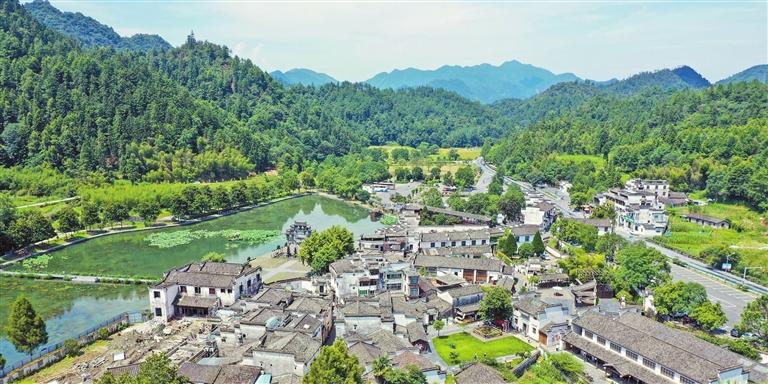
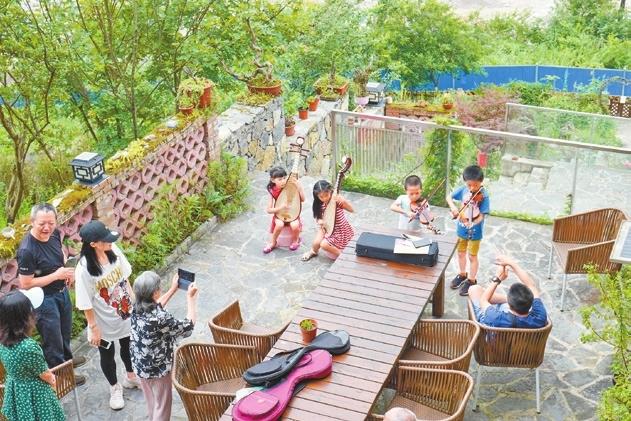
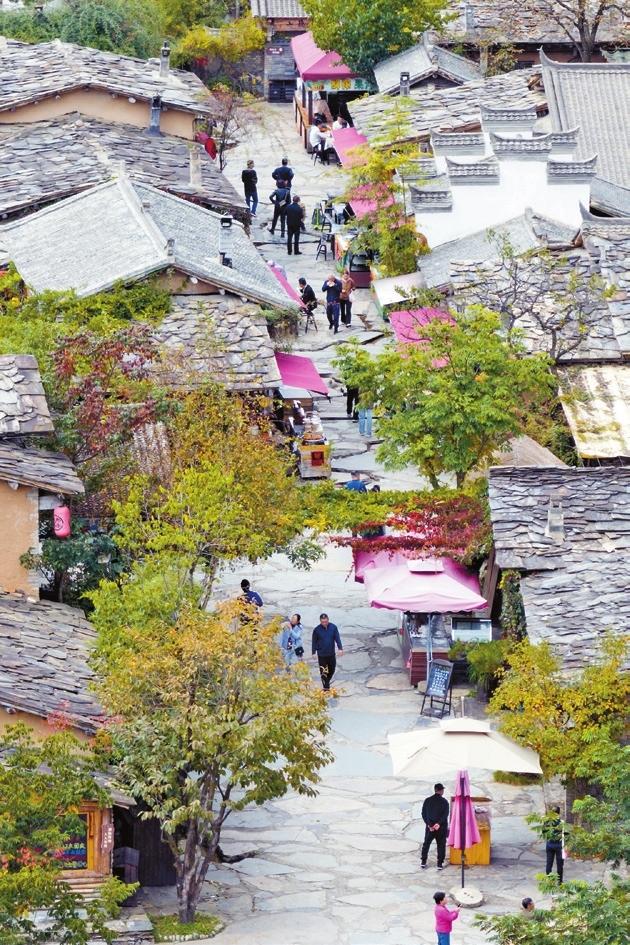
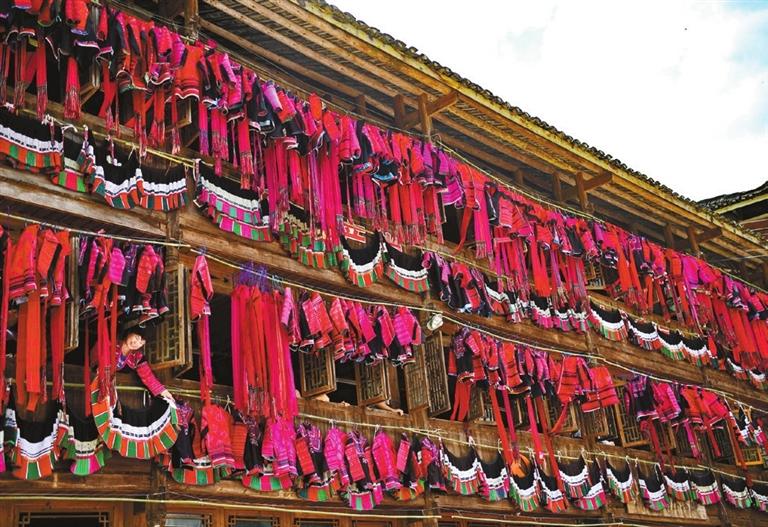
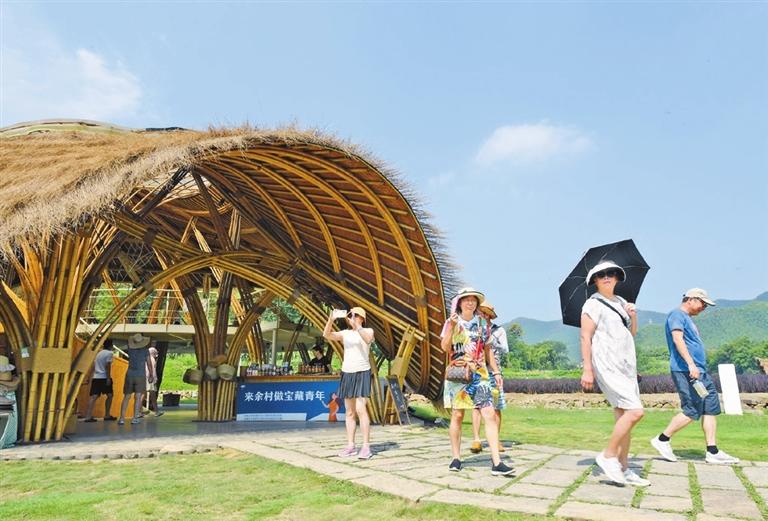
Zhujiawan Village Zhujiawan Village in Zhashui County, Shaanxi Province is located in the hinterland of the Qinling Mountains, with a beautiful environment and rich natural resources. Located at the boundary of the Yangtze River and Yellow River water systems, it covers a sprawling area of 126 square kilometers and boasts an abundance of over 1,200 plant and animal species. Takins, a national protected animal, find their habitats here. Sun Simiao, a legendary Chinese doctor of the Tang Dynasty (618-907) known as the “king of medicine,” had collected herbs in the area. Before tourism increased the locals’ revenues, villagers traditionally depended on herb collecting and logging for their livelihoods. The region also has the remains of Quaternary glaciers, which are valuable for geological research. The village also attracts tourists with its vibrant cultural tapestry, showcasing such intangible cultural gems as the Zhashui Fishing Drum (a traditional local opera) and ancient liquor brewing practices. The village today has plenty of rural homestays and guesthouses, where visitors can stay for a leisurely holiday in the lush surroundings. Tourists can also explore the Niubeiliang Forest Park and a canyon sports park, where such fun experiences as white-water rafting are offered. Dazhai Village Longji’s famed rice terraces have been luring travelers to Guangxi Zhuang Autonomous Region for decades to witness some of China’s most spectacular scenery. Rising to 1,000 meters, they are an amazing feat of farm engineering on hills dotted with ethnic minority villages. Local residents began to build terraced fields to grow rice as early as the Tang Dynasty and the current fields took shape in the early Qing Dynasty (1644-1911). One of two main areas to see is the Jinkeng terraces, with life-affirming viewpoints around Dazhai and Tiantouzhai villages, about 80 kilometers away from Guilin City. The signature outlook is from Golden Buddha Peak, offering astounding views of sculpted terraces that are reached via the cable car from Dazhai or a one-hour hike from Tiantouzhai. Popular sites for shutterbugs, the villages are a gateway to sublime vistas to enjoy at sunrise and sunset. Dazhai Village at the foot of the mountains offers not only grand views of the terraced fields and ancient wooden buildings embraced by the lush surroundings, but also a rich cultural tapestry presenting the traditions of Red Yao ethnic people, who have inhabited the region for over 2,300 years. These people are known for their well-crafted costumes, including embroidered skirts, silver ornaments and headdresses, which were officially recognized as a national intangible cultural heritage in 2014. The local women grow and maintain especially long hair, which they wrap up elaborately in cloth. The visitors can also enjoy folk song and dance performances as well as unique local food. Jingzhu Village Located at an altitude of between 800-1,300 meters in the Fairy Mountain region in Wulong District, Chongqing Municipality, Jingzhu Village is blessed with stunning vistas of forests, alpine meadows, sinkholes, and canyons. With 3/4 of its areas covered by forests, the village makes a beautiful summer getaway and winter skiing resort. Previously difficult to reach, in recent years the village has become a tourist destination with improved facilities. Today, there are some 30 nice homestays and guesthouses scattered around the village, alongside well-designed libraries and cafés. Apart from camping and hiking in the refreshing environments, visitors can also experience fruit picking, batik making, bamboo basket weaving, pottery and other local farm and handicraft traditions. They can also try such local delicacies as mutton soup and a bean curd snack. Xidi Village Xidi Village in Yixian County, Anhui Province is a traditional Chinese village nestled in the southern foothills of Mount Huangshan, covering an area of 10.7 square kilometers. First built during the Song Dynasty (960-1279), Xidi Village prospered in the early Qing Dynasty. The village, whose buildings altogether resemble a big ship, is harbored by lush mountains, with a confluence of two streams meandering through it. Three main streets and several lanes link the historical blocks and are meticulously paved with dark green stones, while the ancient buildings feature wooden structures with dark tiled roofs contrasting beautifully against white brick walls. The architecture also features elaborate wood, stone, and brick carvings. In total, the village boasts over 300 houses from the Ming and Qing dynasties, with 124 of them well-preserved. The memorial arch gate and giant trees at the village’s entrance resemble masts and sails, while the farmland encircling it creates the illusion of a massive ship securely moored in a harbor. Yucun Village Yucun Village in Anji, Zhejiang Province is surrounded by the lush Tianmu Mountain on three sides. About 90% of its 5-square-kilometer land is covered by forests. Once a mining village, Yucun is a sought-after getaway for tourists due to its serene beauty after years of effort to restore and preserve the local ecology. Roads have been built to provide easy access to the village; while infrastructure was upgraded to lure visitors. A sea of bamboo forest, extensive tea gardens and fields replete with colorful flowers now charm visitors at every turn. (Li Dan) | 
